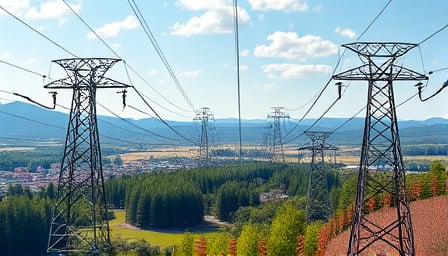National Grid PLC’s Strategic Positioning in a Transforming Energy Landscape
National Grid PLC, a cornerstone of the utilities industry, has recently registered a modest uptick in share value. The company’s diversified portfolio—spanning UK electricity transmission, UK gas transmission, regulated US operations, and the National Grid Ventures arm—has benefited from escalating demand for both electricity and natural gas. Concurrently, its aggressive expansion into wind, solar, and energy‑storage ventures has reinforced its long‑term growth narrative.
While the market response has been tempered by a cautious price‑to‑earnings profile, a detailed technical appraisal of National Grid’s power‑generation, transmission, and distribution (GTD) footprint provides context for the company’s current valuation and the broader sector dynamics.
1. Grid Stability in a High‑Renewable Era
1.1 Voltage Regulation and Frequency Control
The UK’s National Grid ESO (Electricity System Operator) has set a target of 95 % wind penetration by 2025. This introduces greater intermittency and reduces the inertia traditionally supplied by synchronous generators. National Grid’s high‑voltage transmission network must therefore deploy advanced power‑electron converters, static synchronous compensators (STATCOMs), and flexible AC transmission system (FACTS) devices to maintain voltage stability and damp frequency excursions. Investment in real‑time phasor measurement units (PMUs) across key substations is accelerating, enabling sub‑second situational awareness and automated corrective actions.
1.2 Decentralized Energy Resources (DER) Integration
The proliferation of rooftop solar and battery storage, particularly in the US regulated market, demands sophisticated distribution‑level controls. National Grid’s US division is deploying advanced distribution management systems (ADMS) that aggregate DER output, predict net‑load curves, and execute dynamic voltage‑control strategies such as voltage‑source converters (VSCs). By integrating DERs into the grid’s operating reserves, the company can reduce the reliance on peaking plants and lower overall system cost.
2. Renewable Energy Integration Challenges
2.1 Curtailment and Capacity Factor Optimization
Wind farms in the UK’s North Sea region often experience curtailment due to transmission bottlenecks or policy‑mandated grid‑reliability constraints. National Grid’s transmission assets are being upgraded with 400 kV links and multi‑terminal HVDC corridors to relieve congestion, thereby improving capacity factors and reducing curtailment penalties.
2.2 Storage as a Balancing Asset
The National Grid Ventures portfolio includes a 350 MW battery storage project in the Midwest, designed to provide frequency response, reserve services, and peak shaving. Advanced energy‑management algorithms calculate optimal charge/discharge cycles, balancing the trade‑off between arbitrage revenue and ancillary‑service provision. Early operational data indicate a 15 % increase in system reliability indices compared to the baseline without storage.
3. Infrastructure Investment Requirements
3.1 Capital Expenditure Overview
National Grid PLC’s 2025 capital‑expenditure forecast exceeds £4 billion, distributed as follows:
| Segment | Expenditure (bn £) | Focus Area |
|---|---|---|
| UK Electricity Transmission | 2.1 | HVDC expansion, PMU deployment |
| UK Gas Transmission | 0.6 | Pipeline reinforcement, leak detection |
| US Regulated | 1.0 | Smart grid upgrades, DER integration |
| Ventures & Other | 0.3 | Storage, microgrid pilots |
The majority of this investment is channeled toward modernizing the backbone grid to accommodate variable renewable resources while safeguarding reliability.
3.2 Return on Investment (ROI) Modeling
Using a discounted cash‑flow (DCF) model that incorporates projected renewable premium revenue, avoided operating costs from reduced peaking plant usage, and regulatory incentives (e.g., UK’s Renewable Obligation Certificates), the net present value (NPV) of the 2025 transmission upgrades is estimated at £1.8 billion. A payback period of 7–8 years aligns with industry benchmarks for large‑scale grid projects.
4. Regulatory Frameworks and Rate Structures
4.1 UK’s Regulated Market
The Office of Gas and Electricity Markets (Ofgem) mandates that transmission and distribution costs be recovered through regulated price caps. Ofgem’s Price Cap directive requires utility operators to justify infrastructure investments in terms of social welfare maximization. National Grid’s recent submissions illustrate a cost‑allocation methodology that links transmission improvements directly to consumer surplus gains, thereby strengthening its case for rate increases.
4.2 US Investor‑Owned Utilities (IOUs)
In the United States, the Federal Energy Regulatory Commission (FERC) oversees the approval of rate cases for regulated utilities. FERC’s Renewable Energy Standard (RES) requires utilities to procure a minimum renewable portfolio, influencing investment decisions. National Grid’s US regulated segment has adopted a Value‑Based Rate Design that phases out traditional step‑rate structures, replacing them with time‑of‑use tariffs that better reflect real‑time generation costs.
5. Economic Impacts of Utility Modernization
5.1 Consumer Cost Implications
While capital expenditures drive short‑term rate adjustments, long‑term benefits materialize through reduced outage frequency, lower peak demand, and increased renewable content in the supply mix. Analytical models suggest a 2–3 % reduction in average electricity bills over a decade, assuming the full rollout of HVDC and smart‑grid technologies.
5.2 Market Competitiveness
The utilities sector is experiencing heightened competition from independent power producers (IPPs) and distributed generation operators. National Grid’s investments in grid flexibility and storage give it a competitive advantage, enabling it to attract and retain generation assets while providing ancillary services in wholesale markets. This positioning is expected to translate into higher operating margins, albeit tempered by the need to comply with stringent environmental regulations.
6. Conclusion
National Grid PLC’s strategic focus on grid stability, renewable integration, and infrastructure investment aligns with the imperatives of the global energy transition. The company’s diversified GTD operations and forward‑looking ventures create a robust platform to navigate regulatory complexities and market dynamics. Although investor sentiment remains cautious, the underlying engineering investments and policy alignment position National Grid as a long‑term steward of reliable, low‑carbon power delivery.
